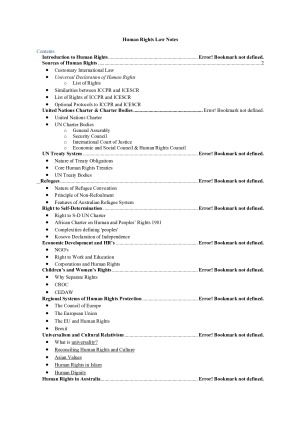Human Rights Law Notes
Subject notes for VU BLB4145
Description
Sources of Human Rights • Int. law regulates relations between states (countries) - does not create direct obligations between a state and its citizens (constitutionalised systems do though) • Int. law is the body of rules which regulates a state’s conduct in relation to other states (and bodies such as the UN) on the international level • Int. law revolves around consent of states • Dualist states - strict separation between domestic/national and int. law o Alleged breach of int. law determined only by tribunal such as UN body • Problem with this? Individuals are the intended beneficiaries of HR’s law, but under ordinary principles of int. law only states (or UN) may enforce these obligations (there are exceptions individual complaints mechanism optional protocol 1 of ICCPR) • Art 38 of the Statute of the International Court of Justice (ICJ) - supreme judicial organ of United Nations - lists main sources of int. law as follows: o Int. conventions or treaties o Int. custom o General principles of law recognised by civilised nations and o Judicial decisions and teachings of the most highly qualified publicists Customary Int. law • ‘Unwritten law’ - based on actual practice of states rather than a written document • Same binding status as a treaty or convention but often difficult to prove its existence and content • Contradicts principle of consent • No actual consent or agreement required for CIL • Oldest original source of int. law • Art. Vienna Convention on the Law of Treaties 1969 o ‘If a new peremptory norm of general int. law emerges, any existing treaty which conflicts with that norm becomes void and terminates.’ Requirements for proving CIL: 1. Unambiguous and uniform (or even consistent) state practice; and a. Followed by significant number of states over a significant period 2. Subjective belief by states that this practice is mandatory a. Followed out of a sense of legal obligation (bound to follow the custom) Status of the UDHR • Preamble and 30 articles setting forth the HR’s and fundamental freedoms to which all are entitled without discrimination: liberty, equality in dignity and rights, security, non-discrimination and a host of civil and political rights (art. 4-21) and economic, social and cultural rights (art. 22-27) UDHR • Not a treaty or convention - not directly binding but may have legal effect as CIL • Paved the direction for all subsequent field of HR’s • Its provisions gave rise to two int. covenants which bind three-quarters of the UN’s membership: ICCPR and ICESCR UDHR Rights: • the right to life, liberty and security of person • equality before the law • the right to freedom of movement and residence • freedom from torture and cruel, inhuman or degrading treatment or punishment • the right to seek asylum in other countries • freedom of thought, conscience and religion • the right to own property • the right to education • the right to work and to form and join trade unions • the right to an adequate standard of living • the right to health care • the right to freely participate in the cultural life of the community Similarities between ICCPR and ICESCR • Preamble and art. 1, 3, and 5 Includes index for easy navigation Includes legislation and case law where relevant
VU
Semester 2, 2017
35 pages
17,352 words
$29.00
6
Campus
VU, City
Member since
June 2015
